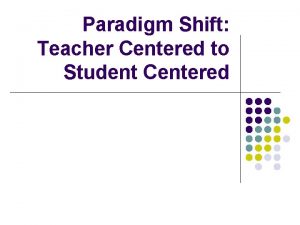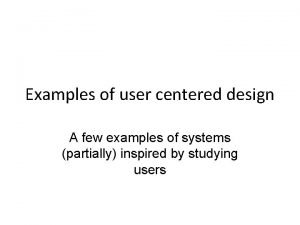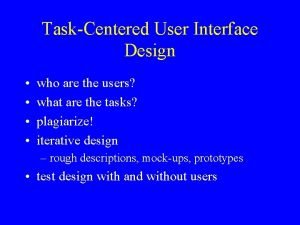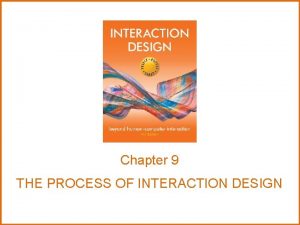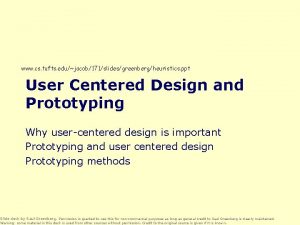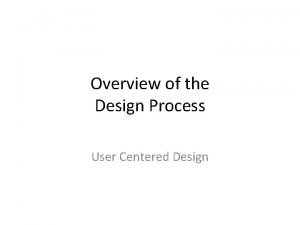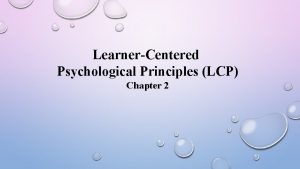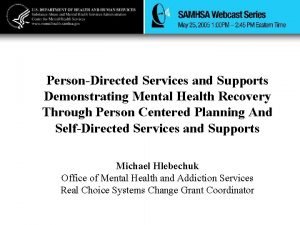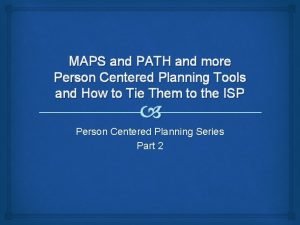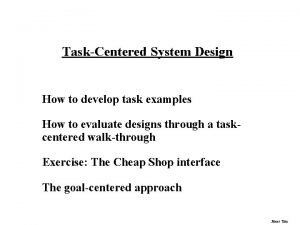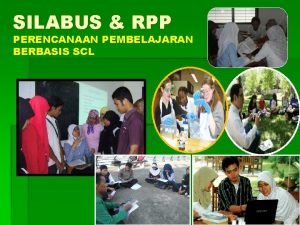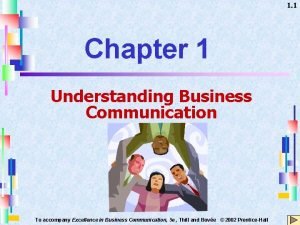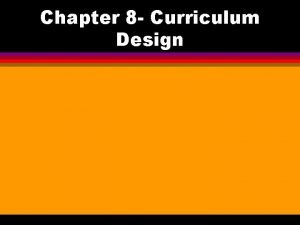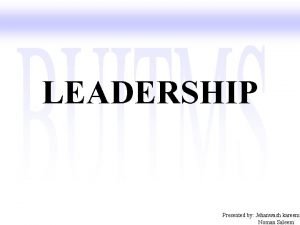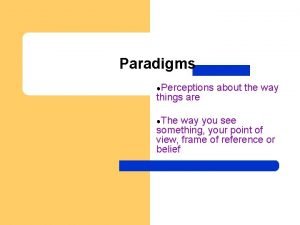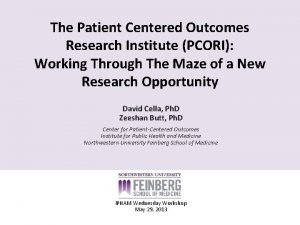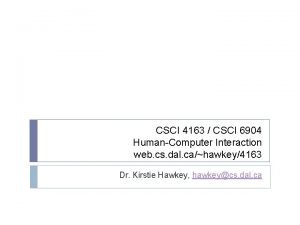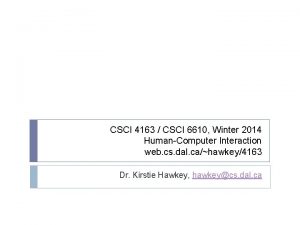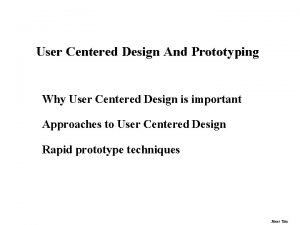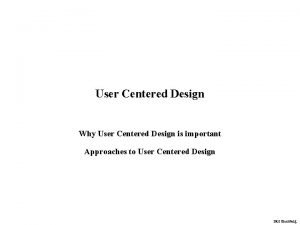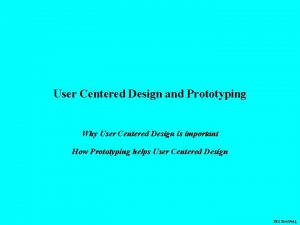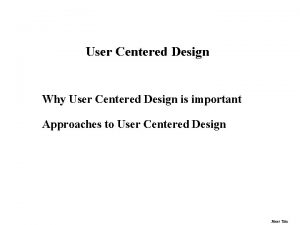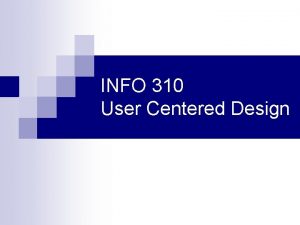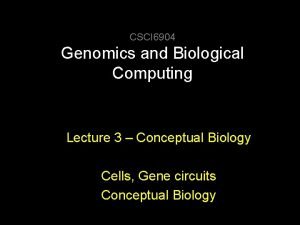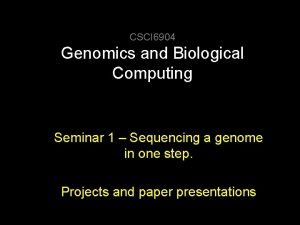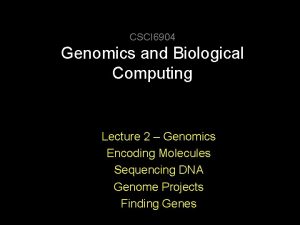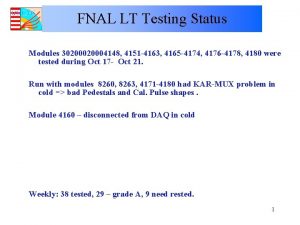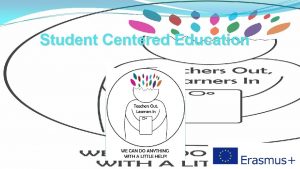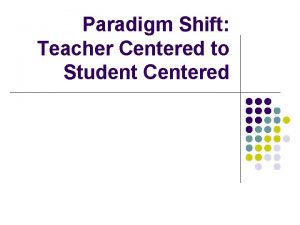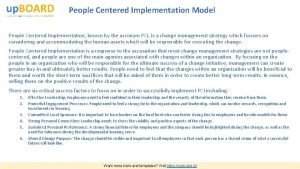CSCI 4163 CSCI 6904 Winter 2013 USER CENTERED

































- Slides: 33

CSCI 4163 / CSCI 6904 – Winter 2013 USER CENTERED DESIGN

Housekeeping Register from the waitlist Course website under construction Need to form MP 1 groups by January 16 th 16 UG’s + 17 G’s = 33 students Want 8 groups => 4 students (1 group of 5) �Can be a mix of grad/UG Seminar topics: UG’s groups of 2, G’s individual 25 topics – will put up lists of topics/dates this weekend Submit preferences by January 17 th (ranking of all)


What is User-Centered Design? An approach to UI development and system development. Focuses on understanding: Users, and Their goals and tasks, and The environment (physical, organizational, social) Pay attention to these throughout development

ISO on User-centered Design ISO 13407 describes human-centered design processes for interactive systems Principles of human-centered design: Active involvement of users Appropriate allocation of function between user and system Iteration of design solutions Multidisciplinary design teams

ISO on User-centered Design (2) Essential activities in human-centered design: Understand specify the context of use Specify the user and organizational requirements Produce design solutions (prototypes) Evaluate designs with users against requirements

What is a user-centered approach? User-centered approach is based on: Early focus on users and tasks: directly studying cognitive, behavioral, anthropomorphic & attitudinal characteristics Empirical measurement: users’ reactions and performance to scenarios, manuals, simulations & prototypes are observed, recorded analysed Iterative design: when problems are found in user testing, fix them and carry out more tests

Four basic activities There are four basic activities in Interaction Design: 1. Identifying needs and establishing requirements 2. Developing alternative designs 3. Building interactive versions of the designs 4. Evaluating designs

A simple interaction design model Exemplifies a user-centered design approach

Some practical issues Who are the users? What are ‘needs’?

Target users

Who are the users/stakeholders? Not as obvious as you think: those who interact directly with the product those who manage direct users those who receive output from the product those who make the purchasing decision those who use competitor’s products Three categories of user (Eason, 1987): primary: frequent hands-on secondary: occasional or via someone else tertiary: affected by its introduction, or will influence its purchase

What are the users’ capabilities? Individual differences: — size of hands may affect the size and positioning of input buttons — motor abilities may affect the suitability of certain input and output devices — height if designing a physical kiosk — strength - a child’s toy requires little strength to operate, but greater strength to change batteries — disabilities (e. g. sight, hearing, dexterity) — abilities also vary according to context

Users’ needs

What are ‘needs’? • Users rarely know what is possible • Users can’t tell you what they ‘need’ to help them achieve their goals • Instead, look at existing tasks: – their context – what information do they require? – who collaborates to achieve the task? – why is the task achieved the way it is? • Envisioned tasks: – can be rooted in existing behaviour – can be described as future scenarios

Brief overview of common methods to gather user data · Interviews · Questionnaires · Observation · Choosing and combining techniques

Interviews • Unstructured - are not directed by a script. Rich but not replicable. • Structured - are tightly scripted, a questionnaire delivered verbally. Replicable but may lack richness. • Semi-structured - guided by a script but interesting issues can be explored in more depth. Can provide a good balance between richness and replicability.

Interview questions • Two types: − ‘closed questions’ have a predetermined answer format, e. g. , ‘yes’ or ‘no’ − ‘open questions’ do not have a predetermined format • Closed questions are easier to analyze · Avoid: − Long questions − Compound sentences - split them into two − Jargon and language that the interviewee may not understand − Leading questions that make assumptions e. g. , why do you like …? − Unconscious biases e. g. , gender stereotypes

Enriching the interview process • Props - devices for prompting interviewee, e. g. , a prototype, scenario

Contextual Inquiry • An approach to ethnographic study. Often conducted as an apprenticeship where user is expert, designer is apprentice • A form of interview, but — at users’ workplace (workstation) — 2 to 3 hours long • Four main principles: — Context: see workplace & what happens — Partnership: user and developer collaborate — Interpretation: observations interpreted by user and developer together — Focus: project focus to understand what to look for

Questionnaires • Questions can be closed or open • Closed questions are easier to analyze, and may be done by computer • Can be administered to large populations • Paper, email and the web used for dissemination • Sampling can be a problem when the size of a population is unknown as is common online

Questionnaire design • The impact of a question can be influenced by question order. • Do you need different versions of the questionnaire for different populations? • Provide clear instructions on how to complete the questionnaire. • Strike a balance between using white space and keeping the questionnaire compact. • Decide on whether phrases will all be positive, all negative or mixed.

Advantages of online questionnaires · Responses are usually received quickly · No copying and postage costs · Data can be collected in database for analysis · Time required for data analysis is reduced · Errors can be corrected easily

Problems with online questionnaires · Sampling is problematic if population size is unknown · Preventing individuals from responding more than once · Individuals have also been known to change questions in email questionnaires

Observation Direct observation in the field Structuring frameworks Degree of participation (insider or outsider) Ethnography Direct observation in controlled environments Indirect observation: tracking users’ activities Diaries Interaction logging

Structuring frameworks to guide observation - The person. Who? - The place. Where? - The thing. What? The Goetz and Le. Compte (1984) framework: - Who is present? - What is their role? - What is happening? - When does the activity occur? - Where is it happening? - Why is it happening? - How is the activity organized?

Ethnography (1) · Ethnography is a philosophy with a set of techniques that include participant observation and interviews · Debate about differences between participant observation and ethnography · Ethnographers immerse themselves in the culture that they study · A researcher’s degree of participation can vary along a scale from ‘outside’ to ‘inside’ · Analyzing video and data logs can be time-consuming · Collections of comments, incidents, and artifacts are made

Ethnography (2) Co-operation of people being observed is required Informants are useful Data analysis is continuous Interpretivist technique Questions get refined as understanding grows Reports usually contain examples

Direct observation in a controlled setting Think-aloud technique Indirect observation • Diaries • Interaction logs

Choosing and combining techniques Depends on The focus of the study The participants involved The nature of the technique The resources available

Mini-project pre-view (1) As a class we will understand user’s behaviours and needs in some activity context Candidate research topic: Co-located group work

Mini-project pre-view (2) Each group will be assigned an approach: Surveys (in-person, on-line) Interviews (structured, semi-structured, unstructured) Focus Groups Direct observation (in the field, in a more controlled environment) Indirect observation (diary studies, activity traces)

Mini-project pre-view (3) Develop specific research questions Appropriate to the approach Design a user study “Submit” ethics (ethics tutorial next week) Pilot during tutorial time (scheduled) With me, with the TA, with other groups Incorporate feedback into study design document As a class, synthesize “results” from various methods Write up report reflecting on methodological choices and appropriateness of study design for research questions
 Paradigm shift teacher-centered to student-centered
Paradigm shift teacher-centered to student-centered User-centered design examples
User-centered design examples Task centered user interface design
Task centered user interface design What are the three principles of user-centered design?
What are the three principles of user-centered design? User centered design ppt
User centered design ppt User centered design process steps
User centered design process steps Es ist kalt es ist kalt flocken fallen nieder
Es ist kalt es ist kalt flocken fallen nieder Winter kommt winter kommt flocken fallen nieder
Winter kommt winter kommt flocken fallen nieder Winter kommt flocken fallen nieder
Winter kommt flocken fallen nieder Single user and multiple user operating system
Single user and multiple user operating system Types of operating systems
Types of operating systems Developmental and social factors 2 principles
Developmental and social factors 2 principles Living a christ centered life
Living a christ centered life Person-centered plan goal examples
Person-centered plan goal examples Character centered approach
Character centered approach What is person centered
What is person centered Design task examples
Design task examples Contoh rpp berbasis scl
Contoh rpp berbasis scl Client centered case consultation
Client centered case consultation Family centered care definition
Family centered care definition An audience centered approach to communication involves
An audience centered approach to communication involves Simple cubic structure coordination number
Simple cubic structure coordination number Teacher centered approach
Teacher centered approach Patient centered care
Patient centered care Disadvantages of problem solving
Disadvantages of problem solving Reliability centered maintenance
Reliability centered maintenance The second rome
The second rome Bounded set vs centered set
Bounded set vs centered set L
L Boss centered leadership
Boss centered leadership Multiple intelligences test
Multiple intelligences test Enemy centered paradigm
Enemy centered paradigm Centered
Centered Earth-centered worldview definition
Earth-centered worldview definition
